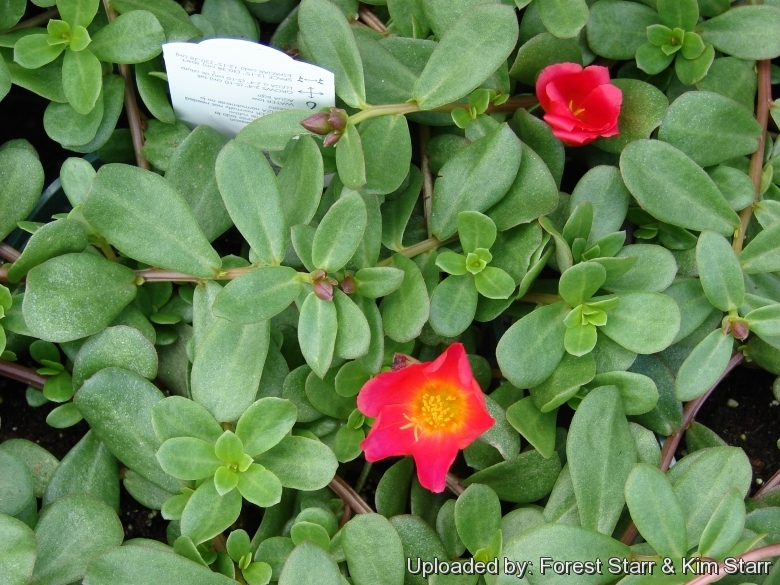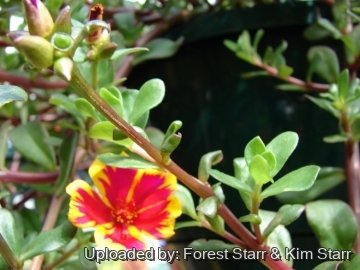
Portulaca umbraticola cv. Wildfire Mixed Photo by: Forest Starr & Kim Starr
Origin and Habitat: The original 'Wildfire Mixed' series was released in the US in 1982-83 by the Pan American Seed company. The original 'Wildfire' series was apparently never patented, so other people actively "extended" the series. The new generations of purslane cultivars are essentially the same as the original series, but some have greater flower abundance, larger flowers, and/or improved colour tones, while others are said to be longer lived.
Synonyms:
See all synonyms of Portulaca umbraticola
Common Names include:
ENGLISH: Wingpod purslane, Purslane
Description: Portulaca umbraticolaSN|29300]]SN|29717]] is an annual (rarely perennial) prostrate to erect herbs succulent herb to 20 cm tall, branched from the base. It has large, translucent single flowers, fleshy stems and leaves that are larger and flatter than those of rose moss (Portulaca grandifloraSN|29334]]SN|29300]]). The plants are robust and the showy flowers are often produced in abundance throughout summer.
Wildfire Mixed: Portulaca umbraticolaSN|29717]]SN|29717]] cv. Wildfire Mixed is a horticultural selection with yellow, white, pink, purple, orange,peachy-pink, coral, apricot and bicoloured large flowers. They grow into low, moderately spreading plants that bloom only when the sun is out, not on dark days or at dawn or dusk. This cultivar of is a common summer garden plants that is sold throughout the world. The original plants used to produce the 'Wildfire' cultivars may have involved a smaller-flowered P. umbraticola subspecies that occurs naturally in the southeastern United States. However the 'Wildfire' series was most likely bred from plants originating in South America, because the flowers of the subspecies found there are much larger, with richer tones and have much greater colour diversity. It is reasonable to presume that the progenitors of the 'Wildfire' series were South American plants that were selectively grown by native plant enthusiasts in the US, who perhaps viewed them as showy and longer-lived "substitutes" for the two native subspecies of P. umbraticola.
Distinctive characteristics: This species is unique by virtue of the membranous wing ('corona') surrounding the basis of the capsule.
Roots: Fibrous.
Stem: Prostrate to suberect. Axillary hairs none or inconspicuous and short at nodes and in inflorescence, stems otherwise glabrous; branches 5–20 cm.
Leaves: Flat, obovate, spatulate or sometimes lanceolate, 10-35 mm long, 2-15 mm wide, apex round to truncate.
Inflorescence: Congested, surrounded by involucre-like 4-5 leaves, with several flowers.
Flowers: 15-30 (or more) mm in diameter. Sepals broadly ovate, ± carinate. Petals spatulate or obovate, 8-15 mm long, 3–6 mm wide, apex acute or cuspidate. Stamens 7-30. Styles (3-) 5 – 8. The petal colour of Portulaca umbraticolaSN|29717]]SN|29717]] cv. Wildfire Mixed includes yellow, white, pink, peachy-pink, coral, apricot, purple, or orange; bicoloured clones are also available.
Fruits (capsules): Obovoid to turbinate, 3 - 5 mm in diameter, with a membranous persistent wing 1-2 mm wide around the capsule just below the flatly convex to flat operculum (lid). Lid thick, nontranslucent.
Seeds: Grey, round or elongate, flattened, 0.5–1 mm; surface cells stellate with long tubercles. There is no seed surface variability in any of the three subspecies.
Note: They are frequently mislabeled as Portulaca oleraceaSN|29300]]SN|29334]] or Portulaca grandifloraSN|29717]]SN|29300]], or as hybrids of these species. This is a reasonable presumption, considering that the vegetative parts of the plants look similar to P. oleracea and the floral parts look similar to P. grandiflora.
Subspecies, varieties, forms and cultivars of plants belonging to the Portulaca umbraticola group
- Portulaca umbraticola Kunth: is an annual (rarely perennial) prostrate to erect succulent herb with flat leaves and multicoloured small flowers. Distibution; North, Central and South America.
- Portulaca umbraticola subs. coronata (Small) J.F.Matthews & Ketron: is a short-lived annual with small, pure yellow flowers. Distribution: South Carolina and Georgia, USA.
- Portulaca umbraticola subs. lanceolata J.F.Matthews & Ketron: is a short-lived annual with small, yellow flowers tipped with coppery red. Distribution: southern USA, west of the Mississippi
 Portulaca umbraticola cv. Wildfire Mixed: is a horticultural selection with yellow, white, pink, purple, orange,peachy-pink, coral, apricot and bicoloured large flowers.
Portulaca umbraticola cv. Wildfire Mixed: is a horticultural selection with yellow, white, pink, purple, orange,peachy-pink, coral, apricot and bicoloured large flowers.
Bibliography: Major references and further lectures
1) Urs Eggli “Illustrated Handbook of Succulent Plants: Dicotyledons” Springer Science & Business Media, 2002
2) Australian Portulaca: a blog dedicated to the identification, appreciation and study of Portulaca species. “The History of Portulaca umbraticola in Cultivation” Saturday, August 10, 2013 <http://australianportulaca.blogspot.it/2013/08/the-history-of-portulaca-umbraticola-in.html> Web. 9 Nov. 2014.
3) Alexa Coelho and Anna Maria Giulietti “Revision of the genus Portulaca in Brazil” Acta bot. Bras. 24(3): 655-670. 2010
4) Jim Wilson “Bulletproof Flowers for the South” Taylor Trade Publishing, 01/Oct/1999
5) 5) James F. Matthews “Portulaca umbraticola Kunth [family PORTULACACEAE]” in: Flora of North America, Vol 4
6) Forest & Kim Starr “Portulaca umbraticola (Wingpod purslane cv. 'wildfire')”. Plants of Hawaii. <http://www.starrenvironmental.com>. 23 Nov. 2014.
 Portulaca umbraticola cv. Wildfire Mixed Photo by: Forest Starr & Kim Starr
Portulaca umbraticola cv. Wildfire Mixed Photo by: Forest Starr & Kim Starr Portulaca umbraticola cv. Wildfire Mixed Photo by: Forest Starr & Kim Starr
Portulaca umbraticola cv. Wildfire Mixed Photo by: Forest Starr & Kim Starr Portulaca umbraticola cv. Wildfire Mixed Photo by: Forest Starr & Kim Starr
Portulaca umbraticola cv. Wildfire Mixed Photo by: Forest Starr & Kim StarrSend a photo of this plant.The gallery now contains thousands of pictures, however it is possible to do even more. We are, of course, seeking photos of species not yet shown in the gallery but not only that, we are also looking for better pictures than those already present.
Read More... Cultivation and Propagation: Portulaca umbraticolaSN|29717]]SN|29717]] is grown in tropical and temperate climates as an ornamental plant for annual bedding or as a container plant. It requires ample sunlight and well-drained soils. It requires almost no attention and spreads itself very easily. Although it survives difficult conditions, plants will produce more lush growth and flowers when provided sufficient moisture and rich soils. The plants can be long-lived providing they are regularly supplied with adequate light, moisture, and nutrients. They can also be successfully "overwintered" if kept on the dry side and out of the frosts.
Soils: it grows well in poor, sandy or gravelly soils. The soil must be very well-drained. It will also thrive in well-drained containers with a mulch of pebbles or sand.
Exposure: Needs full sun to flower.
Waterings: Purslane likes to be grown on the dry side and will die in soggy soil. It is drought tolerant, but flowers best with regular watering. Don't water with overhead irrigation, which can damage the flowers.
Hardiness: Plant seeds or set out plants after all danger of frost has passed.
Pests and diseases: No serious insect or disease problems. Watch for aphids. Stem or root rots can be a problem in wet soils.
Garden Uses: Good for poor dry soils where many other plants struggle. Edging or ground cover for beds, rock gardens or along walks. Containers, hanging baskets. Sprawl over stone walls.
Maintenance: Toward the end of the summer purslane can wear out, exhausted from flowering and setting seeds. Pinch out branch tips if you want bushier plants.
Propagation: Sow seed directly in the garden after last frost date, or start indoors 6-8 weeks earlier. Set out seedlings and purchased plants at last frost date. Plants may self-seed. Seeds are as tiny , so mix them with sand before sowing to make them easier to scatter. Seeds germination period, requires one to two weeks. In warm climates, it may self-seed. Established plants can also be propagated by cuttings.














